#slav mapping
Explore tagged Tumblr posts
Photo

First Slavic States
by zalezsky/deviantart
83 notes
·
View notes
Text
Postal 2 Dude x Slavic s/o headcanons
I decided to write headcanons about what if Dude suddenly started dating a Slav. It seems to me that this gives rise to many interesting topics that can be thought about. Also dedicated to all Slavic fans of Postal, in particular fans of this ginger, schizo cockroach with an unstable psyche <3
I'm also Slavic myself, so I just wanted more representation or something, yeeaahhh.

• The first time you met, Dude couldn’t understand where you were from, although he could hear your accent. This intrigued him a little and he was already making his own guesses. When you told him that you were Slavic, he had a mixed reaction. At first it even seemed to you that he began to look at you with caution and suspicion. He probably even speculated about whether you were an undercover agent or not, but you didn’t want to believe that he could think that way about you. Because it's just silly. And although when you had already started a relationship, this thought still didn't leave you for some time. But you tried not to take it seriously, often joking that you would live with him for 30 years, only to later find out that you were simply gaining his trust and recruiting him all this time.

• There is clearly a language barrier between you two. Most of the time, Dude doesn't pay attention unless you're speaking your native language to someone else. Then he feels deprived and even somehow stupid for not understanding what you are saying. Sometimes he's sincerely surprised when he finds out how familiar to him words in your language sound completely different, or similar, but have a different or opposite meaning. Once you mentioned компот (compote) to him, and he first looked at you suspiciously and asked: “What cumpot?” Although most likely, he just wanted to play a silly joke on you.

• Be prepared for all Dude's stupid and awkward jokes about your country or language. He simply cannot keep his sharp, sassy tongue behind his teeth when he wants to joke. Most often, his jokes are based on the theme of the Soviet Union and stereotypes about your country or all Slavs in general. For some reason, in his brain there is still a fictitious fact that all Slavic countries are still closely connected and similar to each other, as if the USSR never collapsed. Of course, half of his knowledge about the Slavs is based on American films, where Slavic characters were often portrayed as the bad, cold and tough guys. Also, he cannot help but mention vodka to you at least once, although you may not drink it at all. And of course he thinks that it’s always cold in your country and that’s why its people are usually so unwelcoming.

• Dude's geographic knowledge leaves much to be desired, but simply put, he sucks at it. He probably wouldn’t even be able to find France, Sweden or New Zealand on the map on the second try, let alone Ukraine, the Czech Republic, Slovakia, Bulgaria, Serbia or Macedonia. He knows practically nothing about other Slavic countries that are not Russia, so it seems to him that they are all similar, like the languages. Although he has to admit that he likes your unusual accent, which is different from the southern American one he is more familiar with. Sometimes he has screw-ups and he can’t understand what you’re saying the first time, so he asks you to repeat it a couple more times and slowly, but this is just another of the many ways to tease you.

• If you want to teach Dude some words in your language, then it’s better to leave this idea because his silly ass doesn’t hear or learn at all! It's not that he doesn't respect your language and your desire to teach him something new, but he just doesn't think he can understand and remember anything. At first it was funny for him to repeat the words after you, but then he simply refused to do it and pouted gruffly. Maybe he’s just tired of it, or maybe he doesn’t want to seem stupid next to you?

• If you want to let him listen to music in your language or watch movies, then you can try, but Dude will often insert comments like ���How funny that sounds” or “What does this mean? Can you actually translate everything into English for me?” This is sometimes tiring and annoying.

• When Dude somewhere notices some text in a language he doesn’t understand, he always asks you to translate it, as if you were some kind of philologist or teacher. Well, perhaps in his eyes it is so. True, there were several funny incidents.
“Sweetie, can you translate what is written here?”
“Dude... It's Portuguese. I don't know it.”
“Ah. Didn't notice.”

• Dude wouldn’t mind or even be happy if you cooked him dishes from the cuisine of your country. To be honest, man would be happy with any home-cooked food, since his diet of junk food, irregular meals and alcohol on an empty stomach clearly has a bad effect on him. His favorite dishes cooked by you? Probably borscht, dumplings, varenyky, cabbage rolls, potato pancakes, pierogi, shuba salad. He doesn't have the sweetest tooth, he likes salty, hot or smoked food more than sweet. But sometimes he still asks you to bake some cookies, pies, sweet rolls or make kissel. Once upon a time for Easter you baked a traditional Slavic sweet - paska. And Dude certainly liked it, although he is not the biggest fan of raisins. In general, he likes everything that you cook for him, because he doesn’t know how to cook himself, and you’re afraid to let him near the kitchen.
#character headcanons#Postal 2#postal fandom#Postal Dude#postal dude x reader#slavic culture#Slavic Postal fans we should reunite#silly American man
26 notes
·
View notes
Note
Sorry if my question was uncomfortable, but I'm a foreigner and would like to understand more about the "feud" between Greece and North Macedonia. I've seen (heated) discussions between Greeks and Macedonians about culture, but I don't know much about the context. Again, sorry if the question is uncomfortable or insensitive.
I think this Geography Now! video does a good job of explaining the controversy. Basically, the Greek position is that since Slavs came a thousand years after Alexander in the area, and the culture and language of North Macedonians are largely Slavic it's illogical for them to name their country after a Hellenistic kingdom and claim many Greek figures, and also Alexander the Great, as people from their culture.
For clarification, Alexander the Great was certainly Greek and he spoke the Macedonian dialect of Greek which was Doric (for reference the Spartans also spoke the Doric dialect). When North Macedonians say "he was Macedonian" they mean he was from their culture and he spoke their language, and he wasn't Greek.
North Macedonian history tends to confuse the administrative regions with culture and ethnicity because it's convenient to them. It doesn't matter if Kyrillos and Methodios were two Greek brothers from Thessaloniki. To N. Macedonians, because these two brothers were in a region that was occasionally the administrative region of Macedonia, they were "Macedonians", hence "from North Macedonia". To them it doesn't matter that Alexander's birthplace and all important cities of the Hellenistic Macedonian Kingdom are in Greece.
What is crucial to understand about this controversy is that Macedonia for a long, long time, was basically "a geographical region of many mountains". The Greek word Μακεδονία literally means "Mountainous Region", and because it's kind of a distinct region it was a district on its own many times. That's an approximation of the limits of "Macedonia" as a geographical region with distinct characteristics.

Below is the ancient Greek kingdom of Macedonia. However, the people who are now residents of N. Macedonia won't be here for another thousand years!
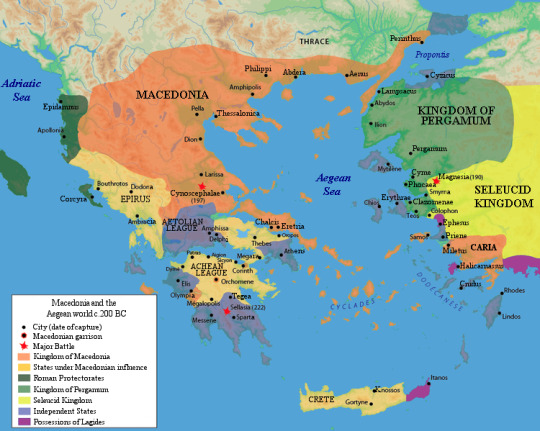
The guy in the video says the Macedonian kingdom expanded, but then he doesn't say that it was separated into more kingdoms for better governance, and one of those kingdoms was this controversial region (in Green) which is now part of Greece and North Macedonia. (Slavs were still not in the area)

When Romans conquered these kingdoms they also separated the area into administrative regions. The province of Macedonia within the Roman Empire, circa 125 (Slavs were still not in the area):
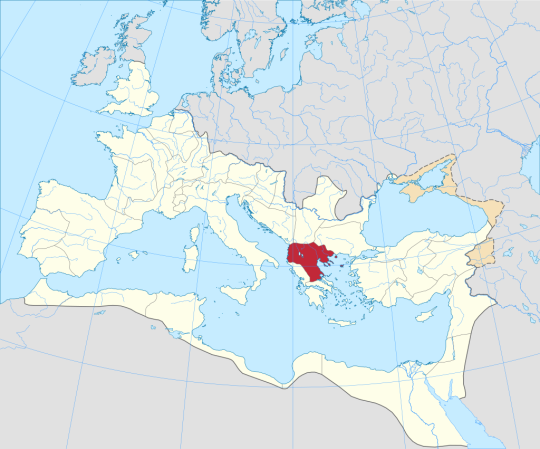
Later administrative departments of Roman empire (Slavs were still not in the area). In fact, "Provincia Macedoniae" changed almost at the time the Slavs arrived, in the 7th century.
Within the Eastern Roman Empire there was later separation into Themata, but now the department of Macedonia was moved to the West, occasionally including parts of the region where N. Macedonia is today. (Slavs in the area after 7th c. ACE)
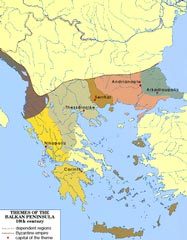
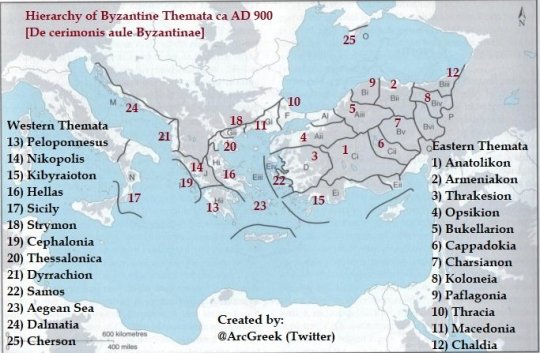

Theeeen came the Turks, and separated the regions differently. Now everyone, Turks, Greeks, Slavs, Hebrews and whoever else lived in that region, are all part of the same "millet", the Rum Millet. "Macedonia" wasn't an administrative area then.

In the 19th century, Turks and Slavs were the majority in the region of Macedonia, with Greeks coming third population-wise, and Hebrews also having very large communities.
(Greeks might not like this fact, or they may ignore it completely, but if you open actual historical books and maps, you'll see the demographics. We have censuses from that era. I learned the old Slavic and Turkic names that villages and places in my region had. There's also a reason Kemal Ataturk's mother wrote to him "They took our Salonik" when Greeks reclaimed the city after 600 years. We can still love our country and appreciate our history, without erasing parts of it.)
In 1912, the largest part of the region of Macedonia was claimed by Greeks. In time more Greeks came to it as immigrants from Anatolia and other Greek regions, shifting the population in such a way that Greeks were now the majority. (North Macedonia still doesn't exist as a country)
In 1991, when the country of North Macedonia was created, Greece already had an administrative region of Macedonia which covered most of the Macedonian geographical area, also the ancient Greek cities of the kingdom, and the emblem of Greek Macedonia was the ancient Greek Macedonian star. The Vergina Star, and the ancient Greek city of Vergina is also in Greek ground today. (Our Emblem and Flag)
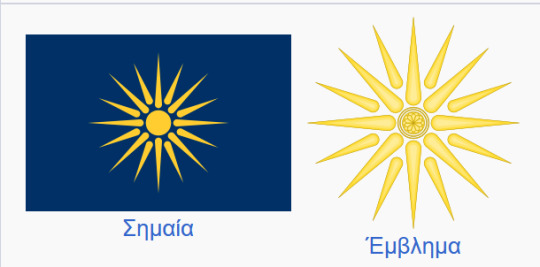
So you can imagine it came as a shock to Greeks when a newly founded country used not only their symbols, but also distinctly Greek symbols. People who are now residents of N. Macedonia lived in the geographical region that a few centuries ago was also "Macedonia" in the administrative sense, so I get where they're coming from. However, when culture gets appropriated, when the culture of important ethnically Greek figures is erased, when Greek words are claimed to be "Macedonian" all of a sudden since 1991, things get tense.
It's a political matter, as the video says. People from the two countries usually have normal interactions if the matter doesn't come up. And I don't think there's hate between the simple people.
#I am not in the mood for a debate I just wanted to explain stuff#make your own post if you want to let off some steam against Greeks :P#answered
66 notes
·
View notes
Text
Viking History: Wends, Balts, and Sámi/Finns - A Raid on Medieval History with Fjorn the Skald
youtube
We’re wrapping up our coverage of the people inhabiting the ‘Viking Age’ North! This time we focus on the ‘side’ characters: Wends, Balts, and Sámi/Finns. As you’ll learn in the video, these groups frequently mingled with the Norse, creating complex settlements and cultural expressions. We’ll also emphasize just how much environment affects cultural development, including seafaring. And of course, you can explore this digital map yourself at fjorntheskald.com/digital-maps!
Key timestamps:
0:06 - Wends
1:30 - Eastern Balts and Slavs
2:30 - Balts
2:55 - Gotland
3:52 - Sámi/Finns
5:35 - Gender-defying, cross-cultural burial
6:12 - Conclusion (key takeaways)
22 notes
·
View notes
Text
I'm probably going to regret writing this as I rarely make non-Sims posts and get involved into political stuff, but I just feel I need to get this off my chest as it keeps bugging me more and more as time goes.
You see, I'm Polish and I see myself as a citizen of the global west. Most Polish people do. The thing is, we are too often put into "Eastern Europe" category by European and American journalists and scholars, which is something we don't identify with.
We speak of ourselves as Central Europeans. Unfortunately, you'll often find people on the Internet arguing that there's no such a thing as Central Europe - only Western and Eastern. If you want to go with this duality, then we'd call ourselves Western not Eastern (however the three groups division is better for describing the nations of Europe, imo).
There are also people who acknowlegde the existence of Central Europe but decide we're not that. Guess who is Central European according to them? Austrians! I've seen an article with Austria put into "Central Europe" bin and Poland, Czechia and Slovakia into "Eastern Europe" bin. Has the author seen a map? Czechia is Austria's northern neighbour. Moreover, Czechia, Slovakia and southern part of Poland were parts of Austrain Empire for crying out loud! So why? Because we're Slavic? Are Slavic people always eastern to you?
We argue that we don't feel eastern for many reasons - e.g. we use latin alphabet, our culture is Catholic Christianity based as opposed to Orthodox Christianity, we live literally in the central part of Europe. What we hear in return is that we're different from Germanic nations. Which like, duh, we are, obviously. But I can assure you average Pole is culturally and mentally closer to average German than to average Russian.
We find being called "Eastern European" offensive, frankly. It sounds to us as if somebody told us we are Russians. That's what Eastern Europe means to us - no human rights, violence and poverty. Now, some people in the west say that means we are Russphobic. I don't know, maybe we are. But you'd probably have similar views if generations of your nation had been subjects to Russian regime, be it tsar or USSR. So, naturally, when Russia attacked Ukraine we had great "disappointed but not surprised" mood.
Many of those people who refuse to call us Central Europeans (as if we aren't good enough to be called that) are progressives, which is quite baffling. If you are leftist and accept that e.g. trans people want to be called by correct pronouns and new names (rightfully so), why the hell can't you accept that we don't identify with Eastern Europe? Both matters are about who you are, how you see yourself and how you identify.
Another thing in a similar vein - it's tiring going abroad and hearing all the time "Oh, you're from Russia?" when people hear you speak in a Slavic language. I don't even know Russian language! This kind of behaviour carries the spirit of Pan-Slavism in Russian fashion - all Slavic nations should be united, but once they would be united, they all would become Russians.
ETA: Another thing I wanted to complain about but I forgot (because this post got quite long) is the depiction of Slavs in pop culture, especially Hollywood movies. They often show Slavs as baddies with thick accent, which is probably a remnant of cold war times. So what we usually get is some kind of token Slav (quite often shown as an ignorant violent drunkard) that is a Russian, because they can't tell us apart and most likely don't even care to create diverse Slavic characters. Even if some non-Russian Slavs are introduced in those media, they still carry Russian traits, like the accent which is pretty different for Polish language and Russian language. And those non-Russian Slavs often speak Russian instead of their correct language. Sometimes it gets even worse as they show Hungarians as Slavs. Like what??? Dude, Hungarians are not even Indo-European. Come on, Hollywood! You can do better than that! /End ETA
Maybe the reason for this kind of division is related to the fact that we were on the eastern part of the Iron Curtain. Nevertheless, it's been over 30 years since the Curtain fell. During this time countries of Central Europe have joined NATO and EU. Our economy looks quite different than it had during communism. We've changed mentally too! More than a generation of people have been born after the fall of communism in Poland - some people born in the 90s already have children on their own. That's two generations!
So, please next time when you hear someone speak Slavic language, don't assume they speak Russian, for God's sake! Just ask them if you have to - just like you'd ask a person about their gender.
This is written from my perspective, so it might differ for other Central European Slavs - Czechs, Slovaks. I'm also curious how similar or different are views of Lithuanians, Latvians and Estonians.
As for the Central Europe discourse, I've read an article of Ukrainian journalist, who argued that the war might lead to Ukrainians identifying as Central Europans as well to strengthen the opposition between Ukrainian nation and Russian nation. That's another thing I'm curious of - how common is that opinion among Ukrainians?
Now I leave you be and go back to simming stuff.
34 notes
·
View notes
Text
This is one of my fav maps, it shows population density of Slavs in the world with the biggest populations mainly being in Eastern Europe (naturally, where they originate from) PLUS neighboring countries, but then it's just BOOM, CANADA
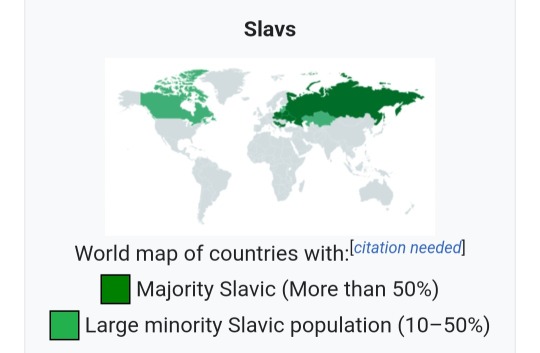
#this is why being mixed Ukrainian (& Algonquian) counts as being Métis bc of the cultural exchange#bc theres so many Slavs in Canada vbsujtffuft#if u go to a government building for say like getting your social security number#one of their main languages offered for service too if u dont speak English is Ukrainian#its right up there with French & German
45 notes
·
View notes
Text
started a new ck3 campaign last night. pagan saxons. specifically started as the "lord" of dithmarschen (roleplaying as a kind of peasant republic). prevented the saxon wars. my mid-term goal is to liberate (conquer) frisia from the franks (want to kinda roleplay creating a hanseatic league analog), but they are still the dominant empire and dwarf us so it will have to wait. in the meantime i am building up my strength by expand eastward, ethnically cleansing the slavs along the way.
somehow i got tangled up in some scandinavian wars and ended up conquering a good chunk of sweden. so i guess i've decided to add a new goal of conquering all of scandinavia. imagine that. a saxon scandinavia. it seems kind of natural though since they (the norse) are the only other germanic pagans on the map right now. may as well unite as a single germanic pagan empire, right?
and on top of that i figured i may as well invade england too. recreate some kind of north sea empire but including saxony too. purify the island of christianity and reunite with our anglo-saxon kin.
#after frisia i want to take northern france#and of course england#to eventually recreate the saxon shore#and ultimately i want to re-germanize and re-paganize all of france
2 notes
·
View notes
Photo

South Slavic ethnic groups in former Yugoslavia.
by geomapas.gr/instagram
73 notes
·
View notes
Text
Have no time & no ideas for the arts, so there's a little Informational something about Lucy (my MC)
∘₊✧────────────────✧₊∘
✧ Her height is 5'35 ft (163 cm)
✧ Her b-day is 18th of April; So she's an Aries and her Arcana in "The Moon"
✧ In addition to magic and fortune telling, she studies astronomy, makes maps of constellations, and reads books on the subject. She also has household basics in sewing, cooking and cleaning, the quality of which is average (the process is complicated by her uncoordination and clumsiness)
✧ Shy, taciturn and not particularly talkative; leads, for the most part, a "modest" kind of life. She is often nervous about trifles and it is easy to hurt her. But, still, she still caring, but in her unusual, modest way
✧ Whenever possible, he tries to help everyone, at once and in everything, which is why he is overworked and has trouble sleeping
✧ The marks under her eyes are not just part of her design, but part of her history and essence. They begin to light up faintly when magic "runs through her veins" and shows a magical connection at a particular moment.
✧ Lucy is a Slav, so most of her notes for herself are written in Russian
∘₊✧────────────────✧₊∘
That's all for now. If you interested.. I can make the second post or answer your questions..

I guess I got hyperfixation on my own MC.. THAT'S SO RIDICULOUS-
#the arcana#the arcana game#the arcana a mystic romance#the arcana mc#the arcana oc#mc#oc#facts#oc info
7 notes
·
View notes
Text
It really, really alarms me the way those IDF victory videos insist on referring to bits of Northern Gaza as "Gush Katif".
I'm reminded of how we were told in school about how the Nazis at the height of their conquest came up with various German-sounding names for eastern European capitals.
I remember that our teacher said the words once so we would recognize them & then cautioned us to never use them, because people who do so today are usually of "dubious politics", and any slavs within earshot would "obviously not like that at all".
Or that talk about how they have maps including, like, chunks of lebanon & jordan and that interview with an extreme settler.
It's like those reportages on TV about - not even the disguised covert wannabe modern Nazis, but the in your face oldschool Nazis that make their kids draw maps with austria included and bits of france & poland 'napped.
the comparison just comes immediately to mind, maybe because of my cultural background - maybe if I was east asian I'd be thinking of imperial japan (many Chinese are, according to what I'm reading as of late)
Like anyone who talks that way is plotting murder.
5 notes
·
View notes
Text
One Man's Fight Against Slavs-Only Apartment Rentals in Moscow
"You have to solve this problem. Otherwise, I will sue, no matter how much it costs me."
By Evan Gershkovich
Feb. 27, 2018
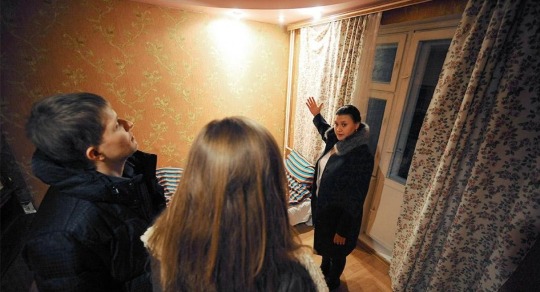
Alexander Ryumin / TASS
The threat was typed in a fit of rage, an emotional outburst that spilled forth after weeks of frustration.
"You have to solve this problem," Emil Allakhverdiev demanded in a viral Facebook post last month. "Otherwise, I will sue, no matter how much it costs me."
Allakhverdiev, 26, was directing his public frustration at Yandex, Avito and the Center for Real Estate Information and Analytics (CIAN), among other Russian apartment rental companies. Hunting online for an apartment in his native Moscow, the English teacher of Azerbaijani descent had run into a ubiquitous fixture: disclaimers that apartments will be rented to ethnic Slavs only.
The practice, aimed squarely at Central Asian immigrants, is one that Russian human rights advocates say has been prevalent in the capital for as long as they can remember. And because it is so entrenched, even Allakhverdiev’s singular Facebook post, they say, represents a step in the right direction.
"It feels like a new moment," Alexander Verkhovsky, the director of the Moscow-based SOVA Center, which tracks nationalism and xenophobia in Russia, told The Moscow Times. "Battling against discrimination requires citizens to be active and lawyers who will litigate strategically and attract media attention."
Although Allakhverdiev has yet to follow through on his threat to sue, he has forced the issue under Russia’s media spotlight. Before speaking to The Moscow Times, he shuttled between appearances on the state-run Moskva 24 channel and the independent Dozhd TV network.
"My primary aim is to bring attention to this problem," he explained in a central Moscow cafe one recent evening.

Emil Allakhverdiev
Facebook
Before setting out on his apartment search three months earlier, Allakhverdiev lived with his mother and rented from a friend. Previously, he hadn’t encountered much racism in Moscow, but the search, he said, had shown him how common it really is.
"It’s not just the disclaimers that you see in one out of every three ads," Allakhverdiev said. "It’s also the real estate agents who, after hearing your last name, just hang up the phone."
In a phone interview, Roman Babichev, who heads the leasing department of the Moscow-based Azbuka Zhilya real estate agency, defended the practice. The goal, he said, is less about keeping apartments in the hands of ethnic Slavs than it is preventing migrant workers from Central Asia and southern Russian republics from turning apartments into "hostels."
"It’s not discrimination," Babichev argued. "People who come from Central Asia, from the Caucasus, from Chechnya and Dagestan" — two predominantly Muslim Russian republics — "will say they will only have three people living in the apartment, but soon 10, 12 people have moved in."
NEWS
Moscow's Most Racist Landlords Revealed
READ MORE
"This is based on years of experience," he added.
Migrant workers from struggling former Soviet republics have long flocked to Russia in search of better wages to send back home. More than a third of Tajikistan’s GDP in 2015, for instance, was earned by workers abroad, 90 percent of which came from Russia. In 2017, authorities estimated that there were about 10 million foreign laborers in the country.
Last spring, Russian researchers at the Robustory data journalism blog found that roughly 16 percent of the ads on CIAN discriminated on the basis of ethnicity or nationality. In their report, the researchers laid out the ads with disclaimers in map form, showing users where it would be easiest to find an apartment.
"This discrimination is not a secret to anyone who lives in Moscow," Vladimir Avetyan, one of Robustory’s researchers, said in a phone interview. "What we wanted to do was to visualize it so that the phenomenon would not just be discussed anecdotally."
Eva Mizrabekyan, 46, was born in Azerbaijan and moved to Moscow in the late ’90s when her Armenian husband found work at a restaurant. In a phone interview, she said she dreaded when the time would come for the couple to find a new apartment.
“My husband is light-skinned, so sometimes we wouldn’t have any problems right away if he went to see the apartment alone,” Mizrabekyan said. “But when it was time to sign the agreement the landlord would find out our name and start cursing and would either try to raise the price or back out altogether.”
“Thank God we found a nice landlord, and for the past seven years we haven’t had to move,” she added.
NEWS
After Metro Blast, Racial Profiling Is on the Rise in Russia
READ MORE
In a statement to Dozhd TV regarding Allakhverdiev’s complaint, CIAN defended the disclaimers on its website.
"Such ads do indeed exist just as, for example, there are disclaimers on ads that say the apartment is ‘only for married couples’ or for those ‘without children’ or ‘without animals,’" the company said. "These disclaimers save our users time."
The company also pointed to Russian law, noting that, while it is clear on employment discrimination, for example, it does not "restrict renters in how they want to manage their private property."
Pavel Chikov, director of the Agora human rights organization, says that the practice is illegal. "The Russian constitution says that you cannot discriminate against people because of their race or ethnicity," he said.
Verkhovsky of the SOVA Center, however, disagrees. Discrimination according to Russian law, he said, is the barring of someone from their rights. "Nowhere in our law," he explained, "does it say that it’s a person’s right to be rented an apartment from another person."
Regardless, to fight the issue, he continued, will require people like Allakhverdiev to demand that discrimination be more thoroughly considered in the courts.
NEWS
Prominent Anti-Racism NGO Sued Under Russian 'Undesirables’ Law
READ MORE
Several days after the interview at the cafe, Allakhverdiev told The Moscow Times that his Facebook post had been removed for containing "open aggression against people on racial, national and religious grounds as well as ethnicity, sexual orientation, gender identity and disability."
The social media platform’s algorithm that removes posts had been hijacked by Russian nationalists sending in complaints, Allakhverdiev suggested. Facebook did not respond to The Moscow Times' requests for comment.
Allakhverdiev also shared screenshots of comments on his original post and messages in his inbox from Russians urging him to leave the country. All of it had made him "want to throw my hands up in the air."
But it wasn't all negative. Others had reached out, too, including some offering him their apartments, and a human rights lawyer who suggested Allakhverdiev file a formal complaint to the Moscow’s prosecutor’s office as an intermediary step before suing. And going to court, Allakhverdiev said, remained an option.
Still, the stream of hate seemed to have taken its toll.
"I am a Russian citizen and Moscow is my home," he said. "Now it doesn’t feel like it so much anymore."
#Old news still a problem#Still a problem#Issues#social issues#racism#russian genocide#indigenous#culture#indigenous russia#indigenous russian#russia#important#colonization#fypシ#fypage#landback#Slavs only#russian imperialism
8 notes
·
View notes
Text
A bit of genetic stuff here for references
This is a general y-dna haplogroup (inherited from paternal chromosome Y) map:

Mongolians and Kazakhs are clustered together under C2 haplogroup (here it’s C3, they’re the same). C2 is the most common ydna haplogroup in both Mongolia and Kazakhstan, and in the case of Kazakhs it means they often have Mongol fathers. This makeup only happened after Mongol expansion to Central Asia under Mongol Empire.
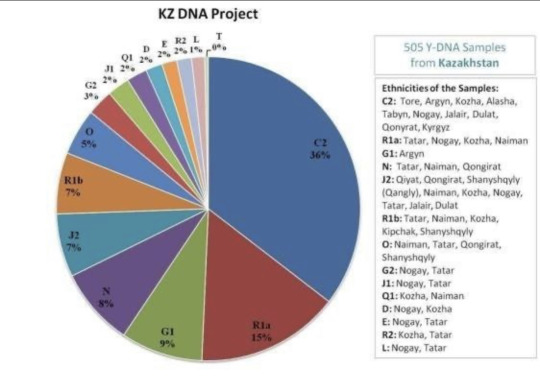
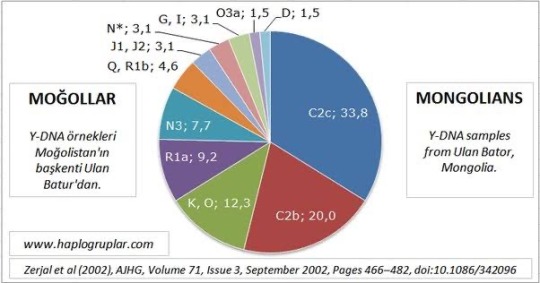
But obviously, Kazakhs are more diverse in general. Haplogroup C2 shows up in 36% of the above samples but idk if it’s representative enough. There are more ydna types like R1b (Western Europe), R1a (Eastern Europe), and G1 is probably Iran.
Haplogroup O is E/SE Asia. K is more unclear, maybe South/SE Asia, maybe West/Central Asia…
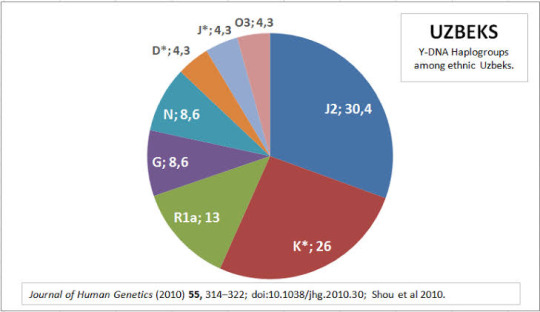
J2 is common around Western Iran, Turkey, Azerbaijan, the Caucasus. Interesting that C2 is lost here. Mongolian heritage among Uzbeks are evident, but this means Uzbeks don’t commonly have Mongol related fathers (so maybe they mostly got it from their mothers?). Modern Uzbeks also are basically a mix of nomadic Uzbeks from Golden Horde era and local sedentary population (+ Uzbekified locals). The loss of C2 here prob also means that nomadic Uzbeks (who had to be Mongolian shifted, being from Golden Horde) were minority among the gene pool.

Kyrgyz are dominated by ydna R1a. It’s common among Eastern Europeans/Slavs, with its origin still debated. Also has a high frequency in Central Asia and near Altai mountains. Kyrgyz people look about similar to Kazakhs and have received lots Mongolian genetic influences from Mongol Empire era, but perhaps this means they mostly got the genes from their mothers and not fathers? Modern Kyrgyz also descended from Yenisei Kyrgyz people who lived around north of Mongolia in medieval era, and it was said that they had ‘red hair and green eyes’.
3 notes
·
View notes
Text
Israeli sources are reporting the arrest of seven Israelis, charged with spying for Iran. The Israelis in the reports I’ve seen are said to be “Jewish”, however I’ve also seen references to unverified reports that they’re Azerbaijani—of Azerbaijani Jewish origin?
MenchOsint @MenchOsint
7 Israelis have been arrested for "allegedly" carrying out spying tasks for Iran, including taking photos and gathering information on Israeli army bases, the Israeli Justice Ministry said.
They gathered information on the Nevatim and Ramat David airbases, the Israeli army HQ in Tel Aviv, Iron Dome batteries, the Golani training base, and other sites, per the instructions of their Iranian operators.
6:23 AM · Oct 21, 2024
Israeli reports identify one as a “deserter”. No doubt we’ll learn more:
MenchOsint @MenchOsint
No mention of them being from Azerbaijan as some other sources say
Quote
Emanuel (Mannie) Fabian @manniefabian [@TimesOfIsrael military correspondent]
Seven Jewish Israelis have been arrested for allegedly carrying out tasks for Iran, including taking photos and gathering information on IDF bases, the Justice Ministry says.
According to a statement from the State Attorney's Office, the seven, from Haifa and other northern towns, include a deserter soldier and two minors.
The seven allegedly gathered information on the Nevatim and Ramat David airbases, the IDF HQ in Tel Aviv, Iron Dome batteries, the Golani training base, and other sites, per the instructions of their Iranian operators.
Indictments are expected to be filed against the suspects on Friday, the ministry adds.
6:25 AM · Oct 21, 2024
On an unrelated matter, while writing I’m listening to a new Ron Unz article, The Total Madness of the State of Israel. This article contains a paragraph that illustrates why I have reservations about Unz, although acknowledging that he’s generally well informed and interesting. However, he sometimes allows his penchant for revisionist history—which I share—get out of hand. This paragraph, while it may seem tangential, is actually a key part of the case that some people advance to claim that WW2 was started by Polish intransigence in the face of Hitler’s purely reasonable attempts to settle border disputes peacefully. That is then used as a basis for sweeping revisionism about Hitler and his aims. Here’s that paragraph:
I’m sure that many brainwashed Westerners would ascribe such statements to Adolf Hitler, believing that exactly such bold public plans of conquest had justified the formation of the global alliance that defeated and destroyed Nazi Germany, but this is total nonsense. During Germany’s period of weakness, Poland had illegally gained control of the 95% German city of Danzig, and after Hitler had peacefully settled all of Germany’s other border disputes, his only remaining demand was that the city be returned to Germany, with that small spark igniting World War II. This important history was discussed at length in 1939 – The War That Had Many Fathers published in 2011 by Gerd Schultze-Rhonhof, a very mainstream German military expert and historian.
I submit that Unz has swallowed German special pleading and revisionism, championed by such as Pat Buchanan. These people regard the Polish Corridor (this article contains useful historical maps) to the Baltic as some sort of injustice to Germany, by separating East Prussia from the rest of Germany. In fact, anyone can consult historical maps to learn that this corridor—inhabited by ethnic Poles and other Slavs—existed for centuries and that this corridor represented the remains of the original Slavic population that had stretched west to the Elbe during the Middle Ages. The German Drang nach Osten over the centuries Germanized that Slavic population, although the remains can be perceived in the remaining Sorb population in East Germany and the fact that DNA studies show that the East German population (I refer to Cold War era East Germany) remains approximately 25% Slavic in origin (also evidenced by the common occurence of Slavic names among East Germans). Even after WW1 the Polish Corridor remained Slavic in origin and language (Polish, with a substantial Kashub minority), although the city of Danzig (Gdańsk) was undoubtedly dominantly German.
0 notes
Note
hello, when you say people in the Balkans who aren't Slavs, like who were there before them, are you referring to Illyrians and Romans and such?
I am referring to currently alive people. You can learn about some of them literally by looking at a map of the Balkans.
#The Illyrians are still alive but they go by Albanians now.#The Balkan descendants of the Romans are called Romanians.#I think the Hungarians got there after the Slavs but I really don't have anything against them.#No Roma ever did shit to me either.#It's a very diverse region.#There's some Turks still they're fine.
0 notes
Text
Slavic Ornament - Projection Mapping Textures Pack Vol.10

Download Slavic Ornament Textures for Video Mapping 100 PNG files with Alpha Channel and Vectors AI formats 100 PNG files with Alpha Channel and Vectors AI formats with traditional national eastern Slavic pattern. Authentic ornaments of Ukrainian, Belarusian and Western Russian peoples clothing for over a thousand years. Red, black and white figures, stripes, lines, etc. Illustrate national character of Eastern Slavs with classic color theme and ornaments. Animate them by your taste and impress your audience! Attention! Projection Mapping Textures is a set of PNG and AI Files WITHOUT ANIMATION. If you need animated facade elements, visit Video Mapping Toolkits category! Projection Textures was developed especially to give Visual Artists possibilities to animate graphic design architecture shapes and express themselves! Video Tutorial - Perform Your Architecture! Create Video Mapping Projections 90% without plugins or scripts! Read the full article
0 notes
Text
Goering and the Hunger Plan

This guy is called Herman Goering. Chances are you've heard of him. This man is famous for having a crippling morphine addiction and stealing from every major French museum during WWII.
While this individual was certainly more eccentric than his other counterparts in the National-Socialist German Workers Party, he was an active participant and architect of a massive scheme to prepare Ukraine for German settlement.
Provided is a rough map of occupied regions circa to the start of 1942 alongside aims for Nazi conquest. The Nazis wanted to execute their General Plan for the East, Generalplan Ost. This envisioned the destruction of existing Slavic settlements in Eastern Europe to make way for German settlement.

This would have ensured the total German domination of Europe in the post war and the Nazis had aims to totally restructure the demographics of Europe. In short, total genocide:

There were many ideas thrown around as to how this could be accomplished. You may be aware of the many death camps in Poland in particular. The problem the Nazis faced was that the sheer size of the planned conquest would have necessitated other methods. The Wehrmacht was encouraged to execute entire villages, the 'Holocaust by Bullet,' as coined by Patrick Desbois, but Herman Goering had his own scheme envisioned in his Green Folder.

This document was created by Goering and used to testify against him in the Nuremburg Trials. Goering planned for the wholesale confiscation of food, which was sorely needed by the Wehrmacht in the war as their logistics could not keep up the war of movement in the East which led to institutionalised looting of everything from food to coats to boots, which was fully intended by Nazi High Command to further accelerate the murder in Eastern Europe when the winter came. Goering in particular was most concerned with the confiscation of food. On July 15, 1941, Goering would go on to write in the folder:
"Use of the occupied territories should be made primarily in the food and oil sectors of economy. Get to Germany as much food and oil as possible - that is the main economic goal of the campaign."
This is a morbid echo of what his peers were thinking. Keitel described the war as:
"An immediate and full exploitation of the occupied areas in favour of the war economy of Germany, particularly in the areas of food and oil"
And, when supervising the headquarters in Oldenburg, Goering said: "In the East, I intend to loot and pillage effectively. All that may be suitable for the Germans in the East, should be extracted and brought to Germany immediately."
It was fully believed by the Nazi High Command that the reconstruction of Eastern Europe post-war would be entirely unnecessary as the raw resources and goods pillaged would be more than sufficient. Surviving Slavs would be worked to death in factories salvaged or, if they had political ties, murdered entirely, with massive atrocities against settlements envisioned such as Leningrad, Moscow and Stalingrad. When the rapid end to the Eastern Front didn't come and the winter of 1941 had settled in with a firm Soviet resistance outside Moscow, the Nazis were forced to consider alternative methods to win the war. But in that time, millions of Ukrainians had already been starved or shot, including 1.5 million Jewish Ukrainians. Overall, 19 million civilians would die under the Nazi occupation of Eastern Europe.

The Green Folder would go on to be used during Goering's trial at the Nuremburg Trials. He would be found guilty of crimes against humanity and sentenced to death. Goering would commit suicide before he could be executed.
I hope this post was helpful in spreading information on Herman Goering's role in the Holocaust and wider Nazi war effort.
#ww2#hermann goering#hermann göring#german history#ukraine#world war 2#history#cw genocide#fascism#nazism#fuck this guy
0 notes